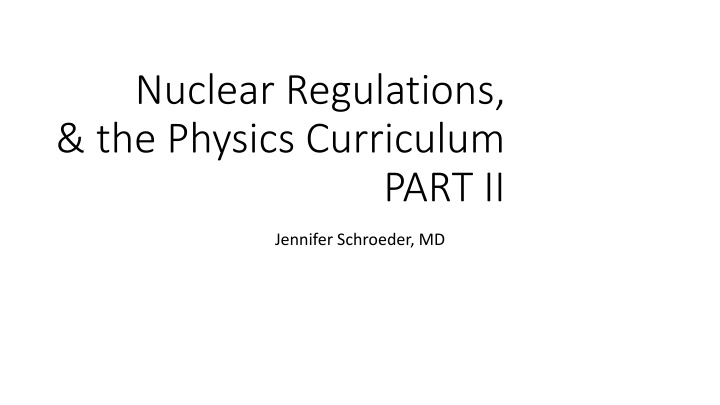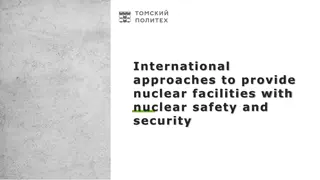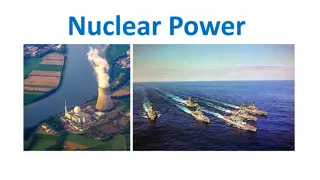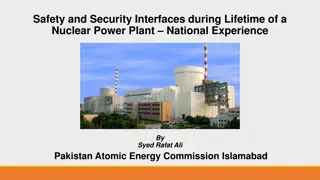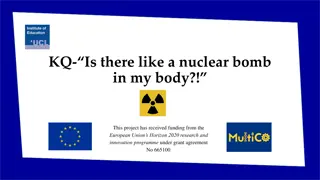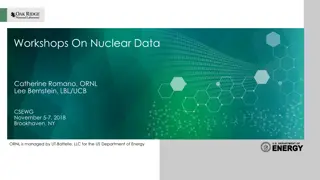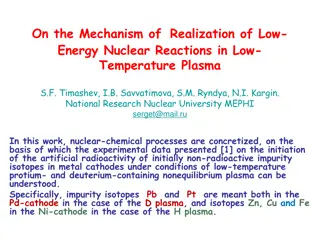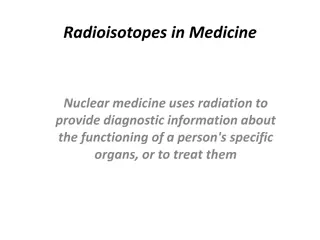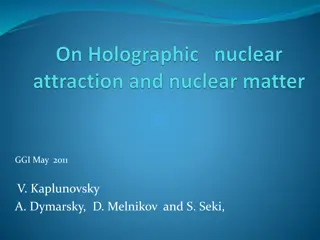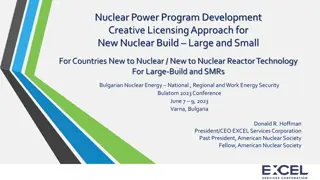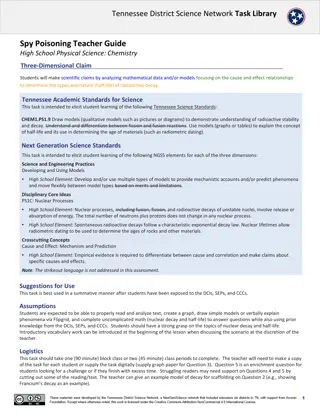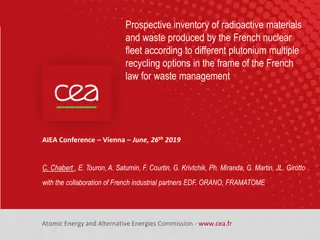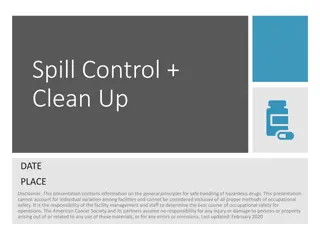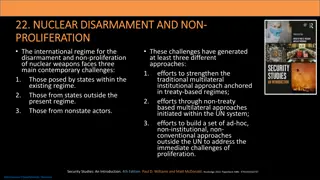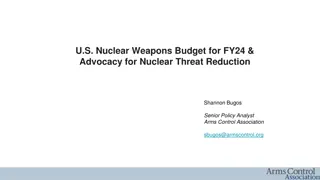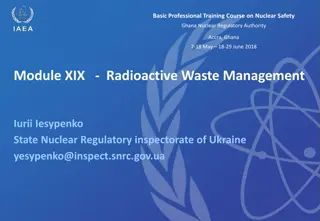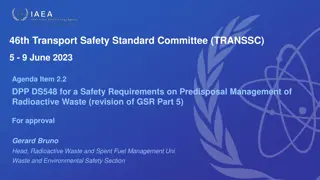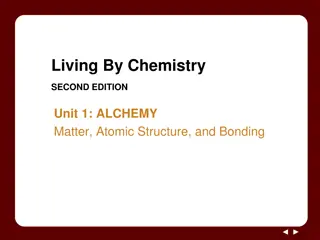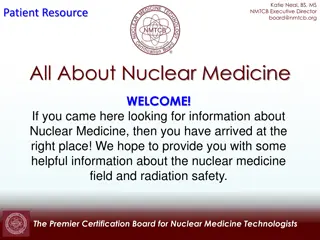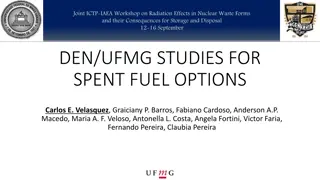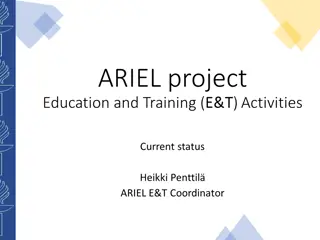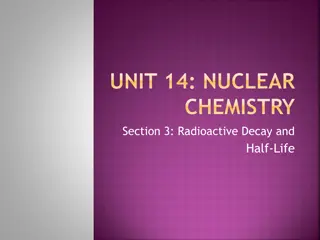Best Practices for Handling Radioactive Spills in Nuclear Medicine Facilities
Understanding the guidelines for dealing with radioactive spills is crucial in nuclear medicine. This comprehensive guide covers major and minor spill scenarios, steps to take in case of a spill, and special considerations for radioactive gas spills. Learn how to ensure safety, prevent contamination, and protect yourself and others in the event of a spill.
Download Presentation

Please find below an Image/Link to download the presentation.
The content on the website is provided AS IS for your information and personal use only. It may not be sold, licensed, or shared on other websites without obtaining consent from the author.If you encounter any issues during the download, it is possible that the publisher has removed the file from their server.
You are allowed to download the files provided on this website for personal or commercial use, subject to the condition that they are used lawfully. All files are the property of their respective owners.
The content on the website is provided AS IS for your information and personal use only. It may not be sold, licensed, or shared on other websites without obtaining consent from the author.
E N D
Presentation Transcript
Nuclear Regulations, & the Physics Curriculum PART II Jennifer Schroeder, MD
Spills*** Major: Generally the longer the half life/ badder the type of radiation, the smaller the amount is considered a major problem. Categories: dose and radiotracer dependent > 100 mCi of Tc99m and Tl-201 > 10 mCi of In-111, I-123, and Ga-67 (half life days) > 1 mCi of I-131 (half life weeks), and I-124 Minor: all other spills
Spills Most likely major spill scenario? Your RAI therapy patient vomited on the way out the department. Or One of the staff dissolved the RAI therapy pill in liquid b/c the patient said they couldn't swallow pills. What to do in these situations?- let s talk
Spills continued What to do Make sure patient is stable Block off area- no people in or out including you! Must be surveyed before leaving so you don't track it all over kingdom-come Clearly label as radioactive spill Alert additional personnel needed to help clean up- if major spill this is the RSO Try not to spread it or get it on yourself If you do get it on you: Remove contaminated items- we will talk about what to do with these Clean affected skin gently with cool water and gentle soap
Spills continued Special considerations When it's a radioactive gas spill Evacuate the area, close the door, and vent the room to outside if possible Eg Xe-133, or that dissolved RAI pill Survey for RAI includes thyroid surveys for those in the area note : all rooms where radioactive gases are use must have negative pressure capabilities- not true for aerosolized agents such as Tc99m-DTPA When it is at the end of the day and area can be secured Can allow for natural decay before clean up begins tomorrow, especially in minor spills with short half lives Must be labeled as such of course and blocked off
Practice question Which constitutes a major spill? a. 5 uCi of I-131 b. 5 mCi of Ga-67 c. 15 mCi Y-90 d. 50 mCi of Tc99m e. 3 mCi of I-124
Practice question Which constitutes a major spill? a. 5 uCi of I-131 b. 5 mCi of Ga-67 c. 15 mCi Y-90 d. 50 mCi of Tc99m e. 3 mCi I-124 Answer: E I-124 is a positron emitter, but can also become volatile and thus is a major environmental control problem. Most forms of radioiodine are volatile if not specially compounded and thus the low dose limit for a major spill. Ref: Appendix (I) in Mettler pg 523
Contamination and disposal Can't throw away radioactive materials into the general waste stream, very regulated. Must survey all materials and have 3 options for what to do next 1. Return to manufacturer in the same container that is clearly labeled 2. Store in a hot lab until decay a. Must be clearly labeled as to the contaminant b. HL must be less than 120 days c. Store for at least 10 half lives d. Exposure must be less than background before releasing into general waste stream e. This includes any contaminated clothing: so if you like those fancy new shoes, don't wear them when your handling radioactive material. 3. Discard into designated hotsink a. Up to 1 Curie per year b. Records of waste must be kept
Contamination & Disposal: Other There is no regulation on excrement of nuclear patients Gases may be vented to the atmosphere in small amounts Though we have a charcoal trap If trap is used, must store till decay! Incineration Will not affect the rate of decay! Must still follow appropriate waste disposal guidelines This is why many nuclear therapies have a Cix of 3 months life expectancy as many crematoriums will not take radioactive corpses until 3 months after last dose.
Practice Question All the prescribed F-18 FDG for the day has been administered, but you still have the vials with trace amounts left. What can you do with them? a. Throw in unlabeled waste bin b. Throw in departmental storage to decay c. Send back to radiopharmacy in unlabeled container d. Discard in the hot lab hot sink
Practice Question All the prescribed F-18 FDG for the day has been administered, but you still have the vials with trace amounts left. What can you do with them? a. Throw in unlabeled waste bin b. Throw in departmental storage to decay c. Send back to radiopharmacy in unlabeled container d. Discard in the hot lab hot sink- cannot get trace amounts out, would just risk contamination if tried to rinse it out Answer: B
Practice question Your standard Cs-137 rod used in calibrating the dose calibrator broke in half when someone dropped it so it can no longer be used. Which option would be best for disposal in this case? a. Hold in storage for decay to background b. Send back to supplier for proper disposal c. Throw in the general waste stream d. Take it home to do experiments with
Practice question Your standard Cs-137 rod used in calibrating the dose calibrator broke in half when someone dropped it so it can no longer be used. Which option would be best for disposal in this case? a. Hold in storage for decay to background b. Send back to supplier for proper disposal c. Throw in the general waste stream d. Take it home to do experiments with Answer: B *** if the HL is greater than 120 days, you cannot store onsite for decay Cs-137 HL= 30 years! Most standards used in equipment calibration have HL>120 days
Practice question How often does sealed sources have to be surveyed for leaks/damage a. Every day b. Every week c. Every 6 months d. Annually e. Once
Practice question How often does sealed sources have to be surveyed for leaks/damage a. Every day b. Every week c. Every 6 months d. Annually e. Once ANSWER: C- regulations state survey for leaks of sealed sources, aka your departmental standards are not to exceed 6 months
Summary of testable rules of half lives Wait to breastfeed until: 4 HL have passed Exception: most therapies- your doneso Too late to image if: >6 HL have passed Wait to discard into general waste stream until: 10 HL have passed
Radiation Areas Areas containing potential exposures to radiation >0.002 rem/hr must be clearly labeled and restricted No access to the general public- locks! Required monitoring of occupational exposure of those who work there Under the supervision of the RSO Examples: See next slide
Radiation Areas Label dose/hour At distance Eg unrestricted Not usually measured, must be less than Waiting room, department bathroom Radiation area 0.005 rem 30 cm Hot lab, imaging rooms High radiation area 0.1 rem ** same amt allowed to the general public in 1 year! 30 cm Cyclotron when not running? Very high radiation area 500 rem 100 cm Nuclear reactor/cyclotron when running
14.4.5.2. Regulatory Considerations/ bodies [2.4] 2. FDA: Food and Drug Administration Regulates radiopharmaceutical development, manufacturing, performance based off of best scientific data Regulates radiation safety requirements related to the production of commercial x-ray equipment and mammography i. Eg FDA controls the monitor resolution and other equipment testing in mammography a. b.
The approval of Lutathera was supported by two studies. The first was a randomized clinical trial in 229 patients with a certain type of advanced somatostatin receptor-positive GEP- NET. Patients in the trial either received Lutathera in combination with the drug octreotide or octreotide alone. The study measured the length of time the tumors did not grow after treatment (progression-free survival). Progression- free survival was longer for patients taking Lutathera with octreotide compared to patients who received octreotide alone. This means the risk of tumor growth or patient death was lower for patients who received Lutathera with octreotide compared to that of patients who received only octreotide. The second study was based on data from 1,214 patients with somatostatin receptor-positive tumors, including GEP- NETS, who received Lutathera at a single site in the Netherlands. Complete or partial tumor shrinkage was reported in 16 percent of a subset of 360 patients with GEP-NETs who were evaluated for response by the FDA. Patients initially enrolled in the study received Lutathera as part of an expanded access program. Expanded access is a way for patients with serious or immediately life- threatening diseases or conditions who
14.4.5.2. Regulatory Considerations/ bodies [2.4] 3. DOT: US Department of Transportation Regulates the transportation of radioactive materials used in nuclear medicine and radiation oncology a.
DOT: US Department of Transportation Receipt of radioactive packages Must be dropped off/stored in a secure and well labeled location Eg our hot lab which is labeled radiation area, and has a automatically locking door with key code access Packages must be surveyed within 3 hours of receipt, or if after hours- within 3 hours of the next business day opening This includes eval for: Contamination: checked with wipes tests Minimum of 100 square cm *** except for gases, eg Xe-133 Dose rate: checked with survey of external radiation while closed Purpose: Evaluates for possible damage If contamination or dose rate is greater than allowed, alert sender and RSO immediately as materials/packaging may be damaged and unsafe Records must be kept for a minimum of 3 years 3-3-3 rule
Transport Regulations*** mrem/hr @ surface mrem/hr @1 meter Generally contain White I < 0.5 <0 assays Yellow II < 50 <1 radiopharm Yellow III > 50 >1 generators Must alert supplying company, RSO, and NRC >200 >10 Badness
Collects, analyzes, develops and disseminates info to the public Makes non regulatory recommendations about radiation protection, measurements, and units- the guessing committee behind tissue weighting factors Advisory body, NOT a regulatory body- aka, recs are just suggestions a. b.
Practice question You have a patient here for a Tc99m MDP three phase bone scan. She is worried about her radiation dose. To put her mind at ease, you tell her the dose is equal to the average radiation person gets from the environment in one year. How much is that? a. 0.3 mSv b. 3 mSv c. 30 mSv d. 300 mSv
Practice question You have a patient here for a Tc99m MDP three phase bone scan. She is worried about her radiation dose. To put her mind at ease, you tell her the dose is equal to the average radiation person gets from the environment in one year. How much is that? a. 0.3 mSv b. 3 mSv c. 30 mSv d. 300 mSv Answer: B Annual average background radiation in America is 3 mSv, most of which is contributed by radon released by decay of Ra-226 in your basement spooky Effective doses for radiation exams in Mettler table 13.2 pg 395
Practice question A patient ingests 100 mCi of I-131 prescribed for a treatment of thyroid cancer, but vomits up the capsule less than 15 minutes later. The capsule appears intact. Why is this NOT a medical event? a. Because the patient received the prescribed dose even though the capsules appeared intact b. Because the change in dose was related to patient intervention c. Because the patient s dose was greater than 20% of the prescribed dose d. Because this is the wrong route of administration
Practice question A patient ingests 100 mCi of I-131 prescribed for a treatment of thyroid cancer, but vomits up the capsule less than 15 minutes later. The capsule appears intact. Why is this NOT a medical event? a. Because the patient received the prescribed dose even though the capsules appeared intact b. Because the change in dose was related to patient intervention c. Because the patient s dose was greater than 20% of the prescribed dose d. Because this is the wrong route of administration Answer: B A change in dose related to the actions of the patient does NOT prompt and NRC report except in two very specific instances: 1. The does results in permanent functional damage to an organ or physiological system 2. The dose results in greater than 5 REM to an EMbryo/fetus (if not approved in advance by the authorize user)
Radiation Emergencies and Disaster Plans KEY <1 = low yield >1.5 =should understand >2 =high yield 3 = will absolutely be at least one question on the exam if not multiple *** have seen similar test questions before Rated as just a 1.8 by the nuclear physics curriculum . So not likely to get a question on the boards- too many other important things to ask about. But as a physician who works directly with radiation, should be familiar with the resources. B/c if anything does happen, your profession will be the first nominated to advise. https://www.nrc.gov/about-nrc/emerg- preparedness.html
